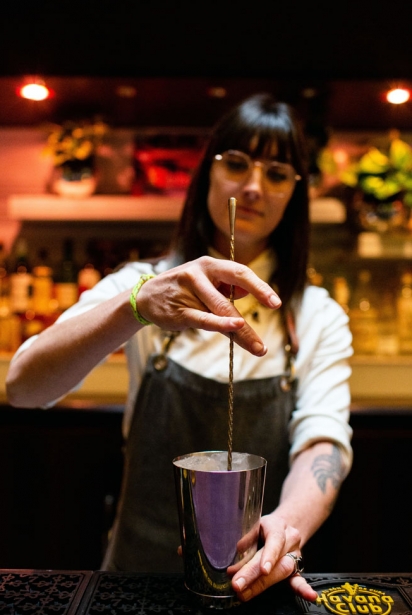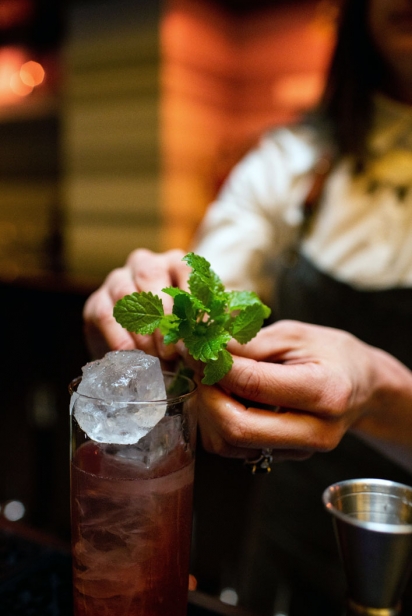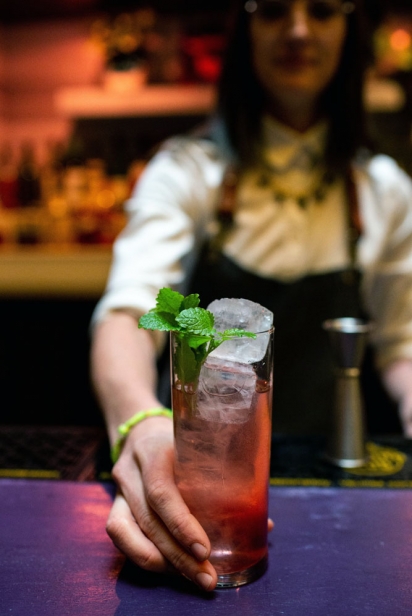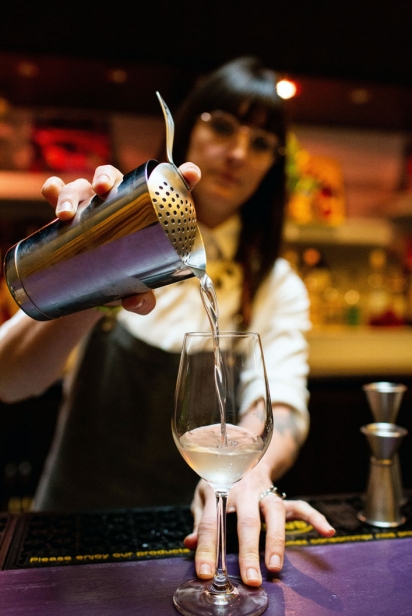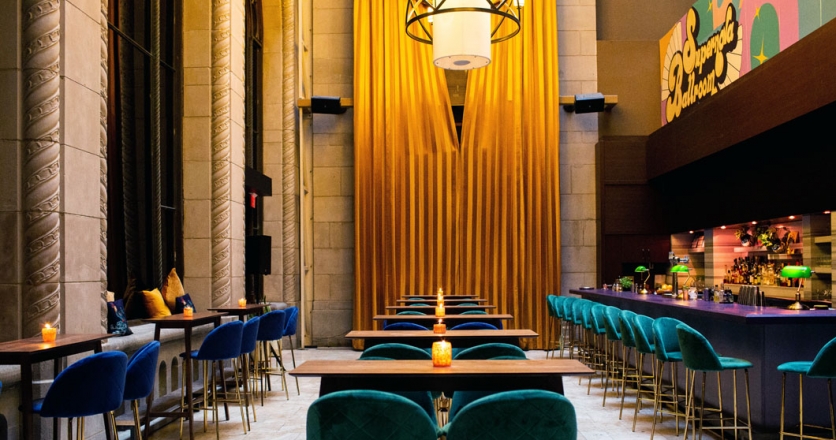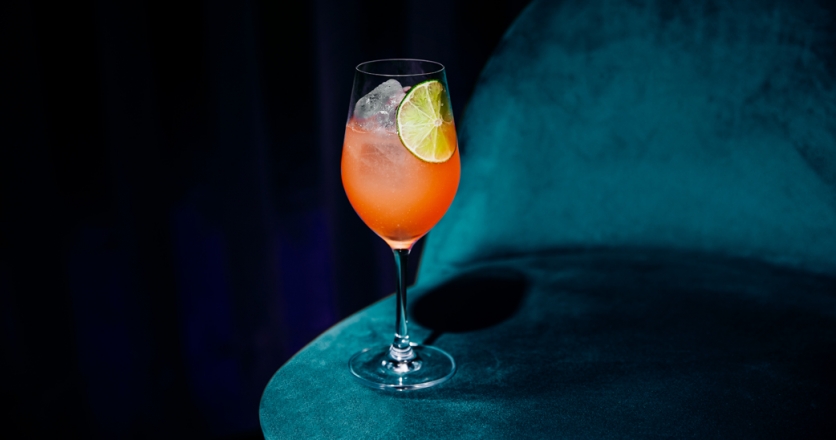When Life Gives You Lemons
Saturday night at Supernova Ballroom is a high- powered, kaleidoscopic time warp — disco-devilled eggs and velour, palo santo and fruit pulp. Dancers take a beat to sip on bellinis and cognac, their sequins swaying at a wholesome 120 beats per minute.
Here, life ambles as mellifluously as Diana Ross crooning on the speakers overhead. It’s positively devil-may-care, but the devil is in the details — whether it’s Oleo Saccharum (a form of sugar syrup made from used lemon rinds) or ingredients sourced directly from farms and distilleries in Ontario — all part of the anti-waste mindset that bubbles to the surface at this Toronto cocktail bar.
Supernova Ballroom, housed inside a Beaux-Arts heritage building in the heart of the financial district, is the latest venture of Kelsey Ramage — award-winning bartender, punk cocktail maven, and co-founder of Trash Tiki, a global anti-waste pop-up and collective. Behind an unassuming concierge desk, tiered chandeliers and vibrant colours marry elegance with early-era disco. The drinks are effervescent and flavour-driven, focused on seasonality and sustainable waste practices.
And they are nearly as eclectic as Ramage’s whirlwind career in hospitality. She spent 15 years globetrotting across continents, from her work as a sommelier and general manager at The Oakwood in Vancouver to a stint as head bartender at internationally acclaimed Dandelyan in London, England — a move that propelled her to new creative heights in 2015.
“We had the goal of putting together one of the best programs and being the best that we could,” Ramage says. “It was just this inspiring style of service that I honestly haven’t seen in North America.”
In London, Ramage discovered newfound inspiration in a community of people who pushed the envelope. But her turning point came after hours, over whiskey with fellow bartender Iain Griffiths — and the conversations that ensued.
“We were discussing this idea of how to train bartenders, and how to take down the [tradition] of recipes being hidden,” she says. “It was only really meant to be an online platform. We were going to post recipes every once in a while, do a couple pop-ups here and there.”
Ramage and Griffiths were interested in tiki culture: sunny and unadulterated escapism down to the extravagant accoutrements. Yet demystifying it for a global community felt incompatible with their work at Dandelyan, churning out 600 drinks a night — and beyond that, the dysfunction of poor waste practices endemic in bars everywhere. Growing the industry and reducing the environmental impact in bars became a core part of the message.
From the culmination of all this, Trash Tiki was born — an initiative that made waves in more than 70 cities, from Sydney to Paris to Bogotá. “We packed up all of our shit into two suitcases and hit the road for nine months straight,” Ramage says. “Played a lot of punk music, spray-painted things. There was that kind of crossover where, yeah, you can have drinks that are sustainably made, but we really want to make it fun. That level of escapism was synonymous with what we were trying to do.”
The pop-ups hosted by Ramage and Griffiths would feature ingredients ordinarily destined for the trash bin — a mix of citrus husks, coffee grounds and avocado pits. Discarded pineapple skins would be fermented, almond croissants, boiled and blended. Spreading the Trash Tiki gospel to “drink like you give a f***” made waves in bars across the world, and propelled the pair to the forefront of the bar sustainability movement. Naturally, it also paid dividends for their personal growth and development.
“Colombia was kind of the pivoting point for us,” Ramage says. “This is a natural progression for cocktail bars in any city — they look to traditional classics. It’s great because then you learn how to build a proper cocktail to balance it properly. You get this scene sort of bubbling up. The thing we saw about Colombia was that scene was happening, but there was such an abundance of natural fruit that wasn’t being translated in the cocktails.”
“There was a disconnect,” she continues. “And that’s when we started talking more about local produce and what seasonality means, and how to get something when it’s at its perfect ripeness. Talking about farmers and agriculture. It was reconnecting people with the system — getting them to learn and think about where things come from.”
It’s a philosophy Ramage now injects into the lifeblood of Toronto’s bar scene. While she and Griffiths are no longer travelling for Trash Tiki, their exploration into uncharted territory continues at Supernova Ballroom — starting with using organic produce wherever possible, supporting minority makers and focusing on seasonality. It’s a little more panache than punk these days, but the bar does a lot to unravel what goes on behind the velvet curtain. “We’re constantly using citrus, and we’re in three feet of snow in January in Toronto,” Ramage says. “Maybe there’s some alternate ways of talking about that, or finding different ingredients that might work to create acidity in a cocktail.”
That ingenuity adds up to balanced and inventive drinks. Be it the umami in clarified white miso married to the brightness of fermented Niagara peach wine, or oyster thief mushroom-infused gin, elevated by the peppery tang of nasturtium leaves. It is all accompanied by a rotating menu of seasonal small plates. In and outside the sphere of sustainability, Ramage and Griffiths continually reimagine the cocktail landscape. But Ramage emphasizes that the work, while ongoing, doesn’t happen in a vacuum.
“While we’re talking about sustainability, one common thing that’s kept us moving forward is having a support network. People don’t f***ing talk about it enough. They don’t talk about the time and effort and the community that you need behind you,” she says. “It’s really inspiring, seeing this community of bartenders coming together that are looking at sustainable practices, and knowing that you’re not alone in this whole process. That we’re all doing this together, tackling it from different sides.”
The side tackled by Supernova Ballroom is bubbly, laser- beam phantasmagoria — a perfect balance of extravagance and kitsch, from Gothic windows to Meco’s Music Inspired By Star Wars And Other Galactic Funk record adorning the shelf. It is, among so many other things, definitively disco. So goes the saying in this plush alternate universe — when life gives you lemon rinds, make a mean lemon Oleo. Lean back, put on your best boogie shoes and hit the dance floor.
SuperNova Ballroom
supernovaballroom.com | 416.710.2764 | @supernovaballroom
Pink Slipper Clutch
30 millilitres vodka
15 millilitres Palo Santo cordial *
10 millilitres Aperol
15 millilitres lemon juice
Scrappy's Black Lemon Bitters
Shake and strain into a glass and garnish with a slice of lime.
Palo santo cordial*
50 grams Palo Santo
650 grams Sugar
650 grams Water
To make a palo santo cordial, lightly burn palo santo until oils come out, sous vide with sugar and water at 60 degrees for 1 hour. Strain out wood.



